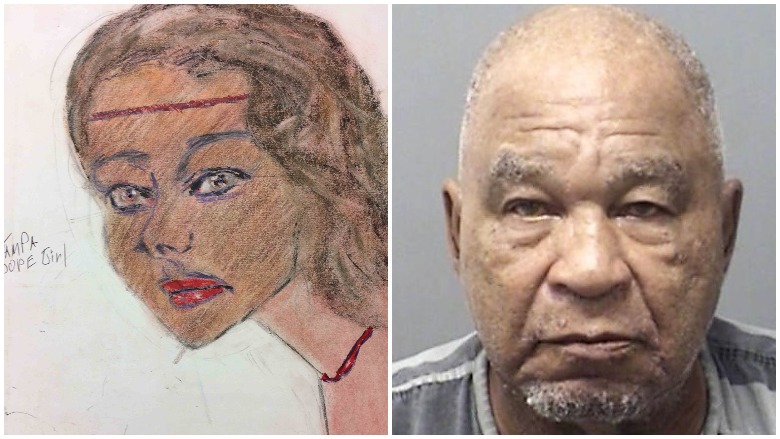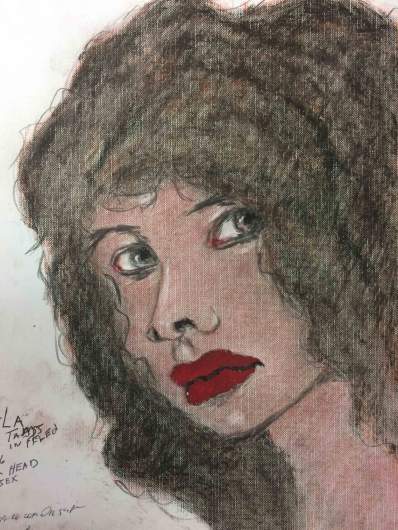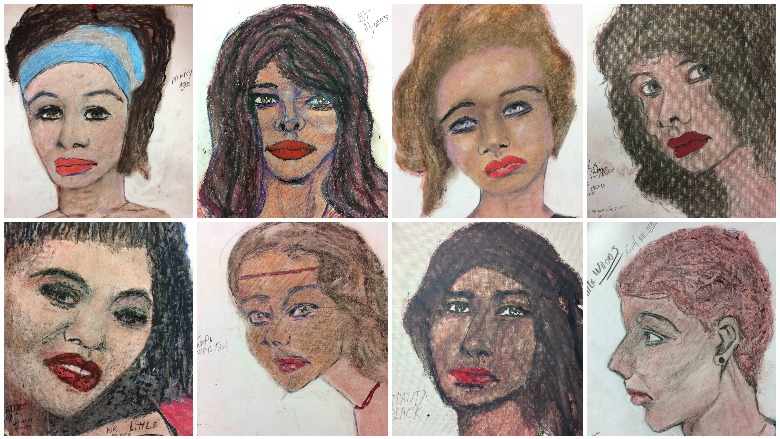
FBI/Wise County Police One of Samuel Little's unidentified victims he sketched/Samuel Little.
Samuel Little may have more blood on his hands than any other serial killer in history. From a Texas prison at age 79, he is working with authorities to identify 93 women he says he killed with detailed sketches.
Samuel Little was born June 7, 1940 in Reynolds, Georgia. Authorities believe he may have been born in jail while his mother, who he described as “a lady of the night,” was serving time, according to The New York Times. The women he targeted in many of his murders were prostitutes. He says his mother was a teenager when he was born, and she abandoned him on the side of the road.
The case is featured on Investigation Discovery’s Serial Killer Week in a four-hour special, “The 93 Victims of Samuel Little.” Part 1 airs at 9 p.m. EST Monday, August 31, 2020, and continues at 9 p.m. EST Tuesday, September 1, 2020.
Little began committing crimes as a teenager with the theft of a bicycle, and he was sent to a juvenile detention center. He left home and lived a nomadic lifestyle, which helped him escape prosecution in his murder spree. He was convicted of crimes including robbery, rape and assault with serious bodily injury, but spent only a total of 10 years in prison in his crime sprees, according to a profile in New York Magazine. He was charged in two murders but escaped conviction.
The Los Angeles Police Department dubbed him “The Choke-and-Stroke Killer” for his sexually motivated crimes. He would often strangle a woman while masturbating.
An FBI database linked Little’s crimes together. He maintained his innocence until 2018, when he began confessing to Texas Ranger James Holland and others. He confessed to killing 93 women from California to Florida between 1970 and 2005. Some women testified at his trial in California they barely survived encounters with Little, according to an appeal filed in the case.
Little is now working with authorities to identify his victims. He draws sketches of the women, which are included in the public FBI data set. Investigators hope to identify all his victims to help bring closure to the families.
Here’s what you need to know:
1. Samuel Little’s Mother Was a Prostitute, Who He Said Abandoned Him on a Road & His Grandmother Raised Him
Samuel Little’s mom was involved in prostitution when he was born. He called her “a lady of the night.” Officials believe he may have been born while his mother was in prison, according to The New York Times.
“Mr. Little has told investigators that his mother had been — in his words — ‘a lady of the night,'” The New York Times reported. “But many other details about his childhood are unclear, although investigators said he may have been born in jail during one of his mother’s arrests. He was raised mostly by one of his grandmothers in Ohio.”
Little was born June 7, 1940 in Reynolds, Georgia. He told New York Magazine Journalist Jillian Lauren his mother abandoned him on the side of a dirt road when he was an infant. A grandmother raised him in Lorain, Ohio. He was convicted of his first crime as a teenager – bicycle theft – and sent to juvenile detention.
Little dropped out of school and became a drifter, sometimes crossing wide swaths of the country in a few short days. With his murders dotting the country, police in a slew of districts were investigating crimes they thought were isolated, and hunting a killer who was difficult to track with no fixed address, according to an FBI profile.
2. Little Lived a Nomadic Lifestyle, Killing Vulnerable & Marginalized Women, Which Helped Him Avoid Detection for Decades

One of Samuel Little’s sketches of an unidentified victim. According to the information Little gave authorities, he killed her in Los Angeles, California in 1996. Her name may have been Sheila. He described her as a black female between 23 and 25 years old.
Little avoided detection for decades by targeting vulnerable and marginalized women, often prostitutes. Several women who narrowly survived encounters with Little reported crimes to police, but no justice came until they were asked to testify at a trial for three counts of murder in Los Angeles. By then, authorities believed they had nabbed a serial killer. One woman was brutally beaten and raped by Little. He served only three months in prison for that crime, according to New York Magazine.
“I never killed no senators or governors or fancy New York journalists. Nothing like that,” he told Journalist Jillian Lauren, who wrote the New York Times profile. “I killed you, it’d be all over the news the next day. I stayed in the ghettos.”
“From the time Little dropped out of high school and left his Ohio home in the late 1950s, he lived a nomadic life,” an FBI profile said. [ViCAP Crime Analyst Christina] Palazzolo and [Department of Justice senior policy adviser and ViCAP liaison Angela] Williamson said he would shoplift and steal in a city or town to gather the money to buy alcohol and drugs, but never stayed in one place for long. He would drive from New Jersey to California in a matter of days, reports Palazzolo, and when he had his many run-ins with police, they often just wanted to shoo him out of town.”
Little chose to kill marginalized and vulnerable women who were often involved in prostitution and addicted to drugs. Their bodies sometimes went unidentified and their deaths not thoroughly investigated.
“Little’s method of killing also didn’t always leave obvious signs that the death was a homicide,” the FBI wrote in its profile of Little. “The one-time competitive boxer usually stunned or knocked out his victims with powerful punches and then strangled them. With no stab marks or bullet wounds, many of these deaths were not classified as homicides but attributed to drug overdoses, accidents, or natural causes.”
3. Little Was Arrested at a Kentucky Homeless Shelter in 2012 & Subsequently Linked to 3 Unsolved California Murders Through DNA
Samuel Little had a series of run-ins with the law, beginning in 1956 with petty crimes like shoplifting, quickly expanding to charges of rape, robbery, fraud, breaking and entering and drug charges. For all of those crimes combined, he only faced a total of 10 years in prison.
“Little’s run-ins with the law date back to 1956, and there are clear signs of a dark, violent streak among his many shoplifting, fraud, drug, solicitation, and breaking and entering charges. But law enforcement has only recently begun unraveling the true extent of his crimes,” says an FBI profile on the serial killer.
His first crime was the theft of a bicycle when Little was a teen. That crime landed him in the Boys’ Industrial School in Lancaster, Ohio, according to New York Magazine.
The links to killings began in September 2012, according to the FBI profile. He was arrested at a homeless shelter in Kentucky and extradited to California, where he was wanted on a narcotics charge. In custody in Los Angeles, police collected his DNA, which matched three unsolved murders between 1987 and 1989. The women were beaten and then strangled. He dumped a body in a dumpster, another in an alley and a third in a garage. Several women testified they had encountered Little and barely survived. Little maintained his innocence. He was convicted on three counts of murder in 2014 and sentenced to three consecutive counts of life in prison without the possibility of parole.
Authorities in Los Angeles asked the FBI’s Violent Criminal Apprehension Program (ViCAP) to complete a full background on Little. The background turned up an “alarming pattern” and compelling links” to more murders. ViCAP made a clear connection to a case in Odessa and contacted Texas Rangers.
“We found a case out of Odessa, Texas, that sounded very much like him, and we could place him passing through the area around the same time,” ViCAP Crime Analyst Christina Palazzolo was quoted as saying in the FBI profile. “We sent that lead out to the Texas Rangers, who were eager to follow up on the long-cold case.”
Palazzolo had worked with Angela Williamson, a Department of Justice senior policy adviser and ViCAP liaison, combing through data on Little. The pair accompanied Texas Ranger James Holland for an interview with Little in California during the spring of 2018.
They found Little willing to talk. He was hoping to move to a new prison.
“Over the course of that interview in May, he went through city and state and gave Ranger Holland the number of people he killed in each place. Jackson, Mississippi — one; Cincinnati, Ohio — one; Phoenix, Arizona — three; Las Vegas, Nevada—one.”
In total, he confessed to 93 murders. Authorities are still working to corroborate details and verify his confessions.
“Williamson and Palazzolo say Little remembers his victims and the killings in great detail,” the FBI profile said. “He remembers where he was, and what car he was driving. He draws pictures of many of the women he killed. He is less reliable, however, when it comes to remembering dates. Little’s uncertain timeline has created a verification challenge for the ViCAP team, along with the issues stemming from the victims Little targeted, his methods, and how much he moved around—features of his crimes that begin to explain how he got away with murder for decades.”
4. Little Was a Competitive Boxer & Left Injuries on His Victims That Shocked a Los Angeles Coroner
Little was a former competitive boxer. He would kill women by beating them and then strangling them.
Little told a Los Angeles detective “he was a boxer, middleweight prize boxer,” according to an appeal filed in California. Another officer described Little as “a big guy, about five-eleven, and I believe 235 was the weight that we used when we booked him,” in his testimony, referring to the arrest in 2012.
Little considered fighting one of his only skills.
“The only things I was ever good at was drawing and fighting,” he told New York Magazine Journalist Jillian Lauren.
“We discussed his hero Sugar Ray Robinson and the prizefighting career Little almost had; he was a light heavyweight who’d been called ‘mad’ for his speed and fury,” she wrote. “The Mad Daddy. The Mad Machine. The Machine Gun. I sat with him for hours that day and returned the next.”
The injuries he left on his victims left an impression in the mind of Dr. Eugene Carpenter, who performed the autopsy on one of Little’s victims, Audrey Nelson. He testified the injuries showed “signs of considerable force” during Little’s Los Angeles murder trial, according to court documents.
“These signs of force are the greatest that I have seen in a 27-year practice in a county which has its share of strangulation cases,” he said.
5. Little Sketches His Victims, Helping Authorities to Close Cases Across the Country

FBISketches Samuel Little drew of some of the women he killed. All of these victims are unidentified.
Little left a trail of bloodshed across the United States from Los Angeles, California to Miami, Florida. He maintained his innocence until 2018, when he opened up to authorities, confessing to killing 93 women. Now, he is sketching his victims and providing the drawings to police, which they hope will bring closure to hundreds of family members who have spent years in the dark wondering what happened to their loved ones. The FBI has compiled a public database of Little’s confessions and his sketches. The database includes 49 confessions which have not yet been corroborated, along with 30 sketches.
The sketches are chilling. Some of the women are smiling. Others are immortalized with a look of fear or despair. Some have their eyes averted. Most are looking straight ahead with a pressing gaze.
Little told New York Magazine Journalist Jillian Lauren the only things he was ever good at were drawing and fighting. He calls the women he killed “his babies,” and often lives in his thoughts remembering them and recounting his murderous acts.
“I live in my mind now. With my babies. In my drawings,” he told Lauren. “The only things I was ever good at was drawing and fighting.”
He told Lauren the story of some of the women he killed, including Denise Brothers, who was murdered in Odessa, Texas, in 1994.
When Little first encountered Brothers, he told her he was an artist. He said he would draw her. After the brutal murder, he did.
Little told Lauren, “‘I told her I was an artist. She was a spicy one. I told her I could draw her so pretty, like van Gogh!’ He cracked himself up with that one. ‘I told her she was beautiful. I said, ‘I love you.’ ”
